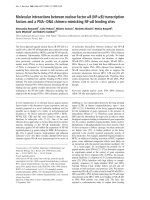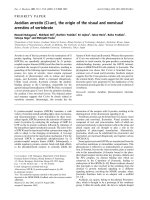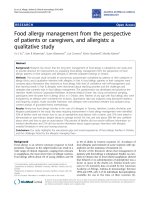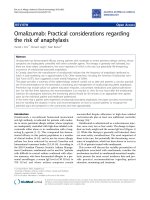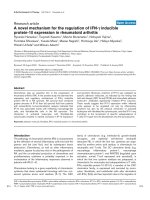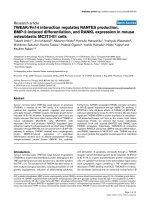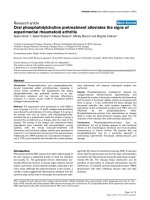Báo cáo y học: "Improving care by understanding the way we work: human factors and behavioural science in the context of intensive care" ppsx
Bạn đang xem bản rút gọn của tài liệu. Xem và tải ngay bản đầy đủ của tài liệu tại đây (226.86 KB, 3 trang )
Available online />Page 1 of 3
(page number not for citation purposes)
Abstract
Effectiveness and efficiency of care of the critically ill patient are
subject to a number of systemic influences, including skills of
individual physicians/nurses (technical and non-technical), team-
working in the intensive care unit (ICU), and the ICU environment.
We first discuss the paper of Fackler and colleagues as a
contribution to the systems approach to clinical performance in the
context of intensive care. We then highlight features of care delivery
that are unique to intensive care and discuss the need for better
understanding of human and non-human elements of the system of
care of the critically ill patient as a driver for improvement of care
delivery.
The past few years have seen a dramatic increase in the
literature of papers investigating behavioural issues in relation
to care delivery. A range of topics are being addressed, with
communication between health care professionals being
perhaps the most-researched aspect of health care workers’
behaviour. Increasing focus on and awareness of safety
issues in care delivery as well as recent changes to clinical
practice (for example, European Working Time Directive) and
training (for example, high-fidelity simulators) have provided
the impetus for this surge in behavioural evidence on the role
of ‘human factors’ in health care contexts.
In the present issue of Critical Care, Fackler and colleagues
[1] published one such paper. The authors used a range of
well-established behavioural science tools and methods
(cognitive task analysis and observations) to study how tasks
are allocated in the clinical environment of the intensive care
unit (ICU). Thematic content analysis of observational and
interview data generated the following categories:
1. pattern recognition
2. uncertainty management
3. creation and transfer of stories
4. team coordination
5. team communication
6. fragmentary teams
7. shifting teams
8. increasing shift handovers
9. role ambiguity
10. external collaborators.
These categories cover a range of skills (for example, story-
building and story-telling and intra-team and inter-team
communication) and tasks (for example, handovers) required
for effective and efficient delivery of care in the ICU.
These findings fit well with the systems approach to human
performance in health care environments [2,3]. The systems
approach postulates that care processes and patient
outcomes are a complex function of a number of factors:
• Individual clinical skills: these include what traditionally
has been termed ‘technical skills’ (for example, diagnostic
skill and motor coordination in central line insertion or
surgical interventions), but also ‘non-technical skills’ (for
example, decision-making in the face of uncertainty) [4].
• Teamwork: teamworking skills include communication
within teams (for example, ICU consultant with nurse) as
well as between teams (for example, recovery team and
ICU team). Other skills related to teamworking are
leadership, team cooperation and back-up behaviours,
and other behavioural skills [5,6].
Commentary
Improving care by understanding the way we work: human
factors and behavioural science in the context of intensive care
Nick Sevdalis
1
and Stephen J Brett
2
1
Clinical Safety Research Unit, Department of Biosurgery and Surgical Technology, Imperial College London, 10th Floor, QEQM Building, St Mary’s
Hospital, South Wharf Road, London W2 1NY, UK
2
Centre for Perioperative Medicine and Critical Care Research, Department of Anaesthesia and Intensive Care, Hammersmith Hospital, Imperial
College Healthcare NHS Trust, Du Cane Road, London W12 0HS, UK
Corresponding author: Nick Sevdalis,
Published: 29 April 2009 Critical Care 2009, 13:139 (doi:10.1186/cc7787)
This article is online at />© 2009 BioMed Central Ltd
See related research by Fackler et al., />ICU = intensive care unit.
Critical Care Vol 13 No 2 Sevdalis and Brett
Page 2 of 3
(page number not for citation purposes)
• Clinical environment: the environment in which care is
provided (ICU and operating theatre) [7,8].
Historically, the systems approach has been developed in more
detail in the context of surgery (Figure 1), possibly because
surgical skills, teams, and environment lend themselves more
easily to observation, measurement, and assessment.
Table 1 illustrates the applicability of the systems approach to
the ICU. The findings of Fackler and colleagues [1] corres-
pond to all systems components: recognising patterns,
making judgements and decisions in the face of considerable
uncertainty, and creating stories are all skills of individual
clinicians. The team-related issues that the study uncovered
reflect the teamwork component of the system. Finally, the
structure of the work requires handovers and close work with
non-ICU staff.
Table 1 also summarises illustrative evidence from other
sources. Firstly, recent research has discovered four inter-
related non-technical skills in the context of intensive care:
task management, teamworking, situation awareness, and
decision-making [9]. Moreover, in the context of critical care,
different methods to assess teamworking (for example, self-
report and direct observation) have been reviewed [10] and
physicians’ versus nurses’ perceptions of their collaborative
work assessed [11]. Other research has revealed discrepan-
cies in views of communication quality (for example, accuracy
and timeliness) between ICU doctors and nurses [12-14],
whereas other studies have linked poor communication with
increased error potential [15]. Furthermore, the ICU has been
analysed as a physical, emotional, and professional work
environment [16]. Observational studies of ICUs have shown
numerous interruptions, affecting mostly doctors but also
nurses [17]. There is an interesting echo here of a previous
study from the same institution, which reported that manage-
ment plans set during ICU rounds were often not understood
Figure 1
Systems approach to clinical performance and error applied to surgery.
OR, operating room. Reprinted from British Journal of Medical and
Surgical Urology, Vol 2 /edition number 1, Shabnam Undre, Sonal
Arora and Nick Sevdalis, Surgical performance, human error and
patient safety in urological surgery, Pages No.9, Copyright (2009),
with permission from Elsevier [3].
Table 1
Systems approach applied to intensive care
System components Evidence from the paper of Fackler et al. [1] Evidence from other sources (sample)
Individual skill (technical Technical:
and non-technical) 1. Pattern recognition
Non-technical: Non-technical skills in intensive care [9]:
2. Management of uncertainty * Task management
3. Creation and transfer of stories * Teamworking
* Situation awareness
* Decision-making
Teamwork and 4. Team coordination Assessment of teamwork in critical care [10,11]
communication 5. Team communication
6. Fragmentary teams Assessment of communication in ICU staff [12-14]:
7. Shifting teams * Aspects of communication: openness, timeliness, and
9. Role ambiguity accuracy
* Interactions between leadership (by doctors and nurses)
and communication
Communication as a source of error [15]
ICU environment 8. Increasing shift handovers Physical, emotional, and professional environment in
10. External collaborators ICUs [16]
Task interruptions in ICU doctors and nurses and
potential for error [17]
ICU, intensive care unit.
by nursing and junior medical staff; the introduction of an
explicit communication strategy resulted in a clearer under-
standing of goals, improved outcomes, and shorter lengths of
stay [18]. It therefore seems unlikely that the observations of
Fackler and colleagues [1] are merely esoteric behavioural
descriptions.
A substantial amount of related work has been undertaken in
the context of anaesthesia and anaesthesia training, and
much of this has been around crisis management (reviewed
in [19]). There is an important contextual difference here.
Although many patients are admitted to intensive care as a
result of or in the middle of some form of crisis, ICU care is
predominantly about dealing with consequences or
preventing crises. Time frames are different and much activity
might be described as routine, albeit complex. Errors leading
to adverse events are often related to sporadic failure of
routine, loss of key information at handover, and clouding of
the narrative of the patients’ illnesses. This is a particular
issue for long-stay patients; all ICU clinicians will recognise
the concept of the occasional dwindling of ‘therapeutic
momentum’, which presents as much a leadership as a clinical
challenge. Clearly, this is not amenable to simulator training –
or, at the very least, it requires ‘outside the box’ thinking about
how to create an appropriate simulation environment.
In an industrial context, the development of a detailed
understanding of how resources and systems interact to
produce an outcome is a prerequisite for quality control and
improvement. Leaving aside equipment for a moment, the
fundamental resources and systems needed for the care of
the critically ill patient are (a) staff, (b) the ways that they
interact with each other, and (c) the non-human elements of
systems (such as hospital design, protocols, and working
practices). Thus, the study of the function of people and
teams at a detailed level is somewhat location-specific, and
studies need to be scrutinised for transferable lessons. Many
of the themes identified in the study of Fackler and
colleagues [1], though undertaken in a single institution in
North America, will resonate and should provoke reflection
and research on local service delivery.
Conclusions
Effectiveness and efficiency of care of the critically ill patient
are subject to a number of influences, including skills of
individual physicians/nurses (technical and non-technical),
teamworking in the ICU, and the ICU environment.
Behavioural research has significant potential to elucidate
these individual influences and their interactions. Better
understanding of these human and non-human elements of
the system of care of the critically ill patient is a prerequisite
for design and successful implementation of interventions
that can improve staff interactions and care delivery.
Competing interests
The authors declare that they have no competing interests.
References
1. Fackler J, Watts C, McHugh A, Miller T, Crandall B, Pronovost P:
Critical care physician cognitive task analysis: an exploratory
study. Crit Care 2009, 13:R33.
2. Vincent C, Moorthy K, Sarker SK, Chang A, Darzi AW: Systems
approaches to surgical quality and safety: from concept to
measurement. Ann Surg 2004, 239:475-482.
3. Undre S, Arora S, Sevdalis N: Surgical performance, human
error and patient safety in urological surgery. Br J Med Surg
Urol 2009, 2:2-10.
4. Yule S, Flin R, Paterson-Brown S, Maran N: Non-technical skills
for surgeons. A review of the literature. Surgery 2006, 139:
140-149.
5. Undre S, Sevdalis N, Healey AN, Darzi A, Vincent CA: Teamwork
in the operating theatre: cohesion or confusion? J Eval Clin
Pract 2006, 12:182-189.
6. Healey AN, Undre S, Sevdalis N, Koutantji M, Vincent CA: The
complexity of measuring interprofessional teamwork in the
operating theatre. J Interprof Care 2006, 20:485-495.
7. Sevdalis N, Forrest D, Undre S, Darzi A, Vincent CA: Annoy-
ances, disruptions and interruptions in surgery. The Disrup-
tions in Surgery Index (DiSI). World J Surg 2008, 32:
1643-1650.
8. Sevdalis N, Healey AN, Vincent CA: Distracting communica-
tions in the operating theatre. J Eval Clin Pract 2007, 13:390-
394.
9. Reader T, Flin R, Lauche K, Cuthbertson BH: Non-technical
skills in the intensive care unit. Br J Anaesth 2006, 96:551-
559.
10. Jeffcott SA, Mackenzie CF: Measuring team performance in
healthcare: review of research and implications for patient
safety. J Crit Care 2008, 23:188-196.
11. Lingard L, Espin S, Evans C, Hawryluck L: The rules of the
game: interprofessional collaboration on the intensive care
unit team. Crit Care 2004, 8:R403-408.
12. Reader T, Flin R, Mearns K, Cuthbertson BH: Interdisciplinary
communication in the intensive care unit. Br J Anaesth 2007,
98:347-352.
13. Reader T, Flin R, Cuthbertson BH. Communication skills and
error in the intensive care unit. Curr Opin Crit Care 2007, 13:
732-736.
14. Thomas EJ, Sexton JB, Helmreich RL: Discrepant attitudes
about teamwork among critical care nurses and physicians.
Crit Care Med 2003, 31:956-959.
15. Alvarez G, Coiera E: Interdisciplinary communication: an
uncharted source of medical error? J Crit Care 2006, 21:236-
242.
16. Alameddine M, Dainty KN, Deber R, Sibbald WJ: The intensive
care unit work environment: current challenges and recom-
mendations for the future. J Crit Care, 2008 Jul 18. [Epub
ahead of print].
17. Alvarez G, Coiera E: Interruptive communication patterns in
the intensive care unit ward round. Int J Med Inform 2005, 74:
791-796.
18. Pronovost PJ, Berenholtz SM, Dorman T, Lipsett PA, Simmonds
T, Haraden C: Improving communication in the ICU using
daily goals. J Crit Care 2003, 18:71-75.
19. Sundar E, Sundar S, Pawlowski J, Blum R, Feinstein D, Pratt S:
Crew resource management and team training. Anesthesiol
Clin 2007, 25:283-300.
Available online />Page 3 of 3
(page number not for citation purposes)
